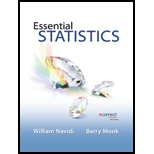
Concept explainers
Keep your password safe: A computer password consists of eight characters. Replications are allowed.
- a. How many different passwords are possible if each character may be any lowercase letter or digit?
- b. How many different passwords are possible if each character may be any lowercase letter?
- c. How many different passwords are possible if each character may be any lowercase letter or digit, and at least one character must be a digit?
- d. A computer is generating passwords. The computer generates eight characters at random, and each is equally likely to be any of the 26 letters or 10 digits. Replications are allowed. What is the probability that the password will contain all letters?
- e. A computer system requires that passwords contain at least one digit. If eight characters are generated at random, what is the probability that they will form a valid password?
a.
Find the possible number of passwords.
Answer to Problem 36E
There are
Explanation of Solution
Calculation:
The password consists 8 characters. Replications are possible. Each character are either lowercase letters or digits.
The Fundamental Principle of Counting:
If an action can be perform in m ways and another action can be perform in n ways then both the action can be done together in mn different ways.
The password consist 8 characters. Each character are either lowercase letters or digits.
Each digit can arrange in 10 different ways and letters can arrange in 26 different ways. That is each character can be arranged in 36
Thus, there are
b.
Find the possible number of passwords if each character may be any lowercase letters.
Answer to Problem 36E
There are
Explanation of Solution
Calculation:
The number plate contains lowercase letters. Each letters can arrange in 26 different ways. Substitute these values in the fundamental principle of counting.
Thus, there are
c.
Find the possible number of passwords if each character may be any lowercase letters or digits, and at least one character must be digit.
Answer to Problem 36E
There are
Explanation of Solution
Calculation:
Number of passwords with each character may be any lowercase letters or digits, and at least one character must be digit can be obtained by the formula:
From part (a), it is clear that there are
From part (b), it is clear that there are
Substitute these values in the above equation.
Therefore, required number is,
Thus, there are
d.
Find the probability that the password will contain all letters.
Answer to Problem 36E
The probability that the password will contain all letters is 0.074.
Explanation of Solution
Calculation:
The probability of an event can be obtained as shown below:
Event A denotes that the password will contain all letters.
From part (a), total number of password is
From part (b), numbers of password will contain all letters is
Substitute
The required probability is obtained as follows:
Thus, the probability that the password will contain all letters is 0.074.
e.
Find the probability that the password contain at least one digit form a valid password.
Answer to Problem 36E
The probability that the password contain at least one digit form a valid password is 0.9260.
Explanation of Solution
Calculation:
Event B denotes that the password contain at least one digit.
From part (a), total number of password is
From part (c), numbers of password will contain at least one digit is
Substitute
The required probability is obtained as follows:
Thus, the probability that the password contain at least one digit form a valid password is 0.9260.
Want to see more full solutions like this?
Chapter 4 Solutions
Essential Statistics

